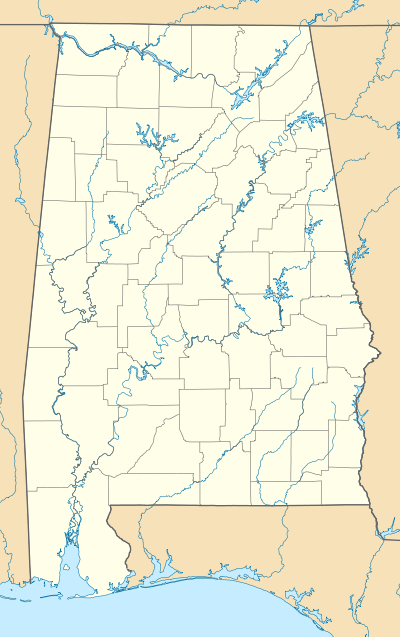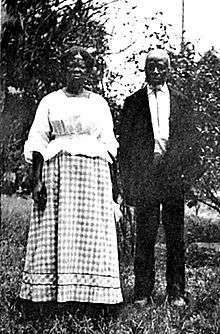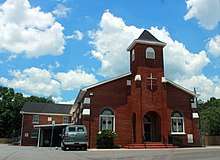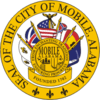Africatown
|
Africatown Historic District | |
.jpg) Africatown welcome sign, 2017 | |
 | |
| Location | Roughly bounded by Jakes Ln., Paper Mill & Warren Rds., Chin & Railroad Sts., in Mobile, Alabama |
|---|---|
| Coordinates | 30°44′7″N 88°3′31″W / 30.73528°N 88.05861°WCoordinates: 30°44′7″N 88°3′31″W / 30.73528°N 88.05861°W |
| NRHP reference # | 12000990[1] |
| Added to NRHP | December 4, 2012[1] |
Africatown, also known as AfricaTown USA and Plateau, is a historic community located three miles (5 km) north of downtown Mobile, Alabama. It was formed by a group of 32 West Africans, who in 1860 were included in the last known illegal shipment of slaves to the United States. The Atlantic slave trade had been banned since 1808, but 110 enslaved people held by the Kingdom of Dahomey were smuggled into Mobile on the Clotilda, which was burned and scuttled to try to conceal its illicit cargo. More than 30 of these people, believed to be ethnic Yoruba and Fon, founded and created their own community in what became Africatown.[2] They retained their West African customs and language into the 1950s, while their children and some elders also learned English. The last survivor of the original group, Cudjo Kazoola Lewis, lived until 1935.[3]
Down from a peak population of 12,000, when paper mills operated there, in the 21st century the community has about 2,000 residents. It's estimated 100 of them are descendants of the people from the Clotilda. Other descendants live across the country. In 2009 the neighborhood was designated as a site on Mobile's African American Heritage Trail. The Africatown Historic District was listed on the National Register of Historic Places in 2012. Its related Old Plateau Cemetery, also known as Africatown Graveyard, was founded in 1876. It has been given a large historical plaque telling its history.
History
In 1860 some wealthy slaveholders of Mobile and their friends decided to see if they could evade the federal law that prohibited importing slaves from Africa. This Atlantic slave trade had been prohibited by the United States by the 1807 Act Prohibiting Importation of Slaves, although the domestic slave trade continued. The slavetraders bet each other and a group from New England that they could evade federal authorities.[4] Timothy Meaher, a shipbuilder and landowner; his brother Byrnes (also spelled Burns) Meaher; John Dabey; and others invested money to hire a crew and captain for one of Meaher's ships to go to Africa and buy enslaved Africans.
They used Timothy Meaher's ship Clotilda, which had been designed for the lumber trade. It was commanded by Captain William Foster. While the ship was in port at Whydah, in the Kingdom of Dahomey (present-day port of Ouidah in Benin), additional work was done to accommodate and conceal the transport of the enslaved people. It sailed in May 1860 from Dahomey for its final destination, Mobile, with 110 persons held as slaves. Foster had paid for 125 slaves, but as he was preparing for departure, he saw steamers offshore and left rapidly to evade them.
The captives were said to be mostly of the "Tarkbar" tribe, but research in the 21st century suggests that they were Takpa people, a band of Yoruba people from the interior of present-day Nigeria. They had been taken captive by forces of the King of Dahomey. He sold them into slavery at the market of Whydah. The captured people were sold for $100 each to Foster, captain of the Clotilda.[3][5]

In early July 1860, the Clotilda entered Mobile Bay and approached the port of Mobile. Trying to evade discovery, Foster had the ship towed at night upriver beyond the port. He loaded the slaves onto a steam riverboat and sent them ashore; he set fire to the Clotilda and scuttled it to hide the evidence of its smuggling slaves. The Africans were distributed among the parties who had invested in the venture. They built shelters of whatever they found growing in the Alabama lowlands, and adapted their hunting to the rich game.
US v. Byrnes Meaher, Timothy Meaher and John Dabey
Federal authorities prosecuted Meaher and his partners, including Foster. Lacking the ship and related evidence, such as its manifest, the 1861 federal court case of US v. Byrnes Meaher, Timothy Meaher and John Dabey did not find sufficient grounds to convict Meaher. The case was dismissed. Historians believe the start of the American Civil War contributed to the federal government's dropping the case.[3][5]
Post-Civil War to World War II
Meaher initially used 32 of the enslaved Africans as workers on his plantation. After the Civil War (1861-1865) they were emancipated, but they continued to work Meaher's property in the delta north of Mobile on the west side of the river. The formerly enslaved people developed a community known as Africatown, bounded on three sides by water: a bayou, Three Mile Creek (formerly Chickasabogag Creek),[6] and the Mobile River.
Among the first settlers of Africatown was a man named Cudjoe Kazoola Lewis (his Yoruba name was Kazoola or Kossola), he was said to be the oldest slave on the ship and a chief. Accounts also refer to Charlie Poteet as a chief. Their medicine man was named Jabez, or Jaba. Charles Lewis (Oluale was his Yoruba name) and his future wife Maggie were also among the Africans on the Clotilda. Cudjoe Lewis was the last survivor of the original group, living until 1935.[3][5]
In the post-Civil War period, the people in Africatown were joined by people from the same ethnic groups living in the Mobile area, who formed their own community groups to escape supervision by whites. The community had two major sections: the first and larger one, of about 50 acres, and a second section of about 7 acres, located about two miles west.[7] The latter area was called Lewis Quarters after founder Charlie "Oluale" Lewis[7] and his wife Maggie.

Cudjo Lewis's son Joe (Joseph) learned to read and write at the church the settlers founded in Africatown.[8] He helped preserve the story of his father and the Clotilda as did the families and later community schools through oral histories. The women raised and sold crops, and the men worked in mills for $1 a day, saving money to purchase the land from Meaher. When possible, they avoided white people. They established the African Church, later known as the Old Landmark Church. In the early 20th century, they replaced it with the brick Union Missionary Baptist Church, which is still in use.
In 1876 they opened the Old Plateau Cemetery, also known as the Africatown Graveyard.
The community started the Mobile County Technical School, its first public school, in 1880.
Cudjoe Lewis helped his fellow African-Americans adapt to their new country, although they had been badly treated by whites. For decades, he served as a spokesman for the people of Africatown. He was visited by American writer Zora Neale Hurston and educator Booker T. Washington, president of Tuskegee Institute. In 1927, Hurston interviewed Cudjo Lewis for the Journal of Negro History. Although she never published the article, she made a short film about him. The manuscript of her research, Barracoon: The Story of the Last "Black Cargo", was posthumously published in an annotated edition in May 2018.
During interviews, Lewis would tell about the civil wars in West Africa, in which members of the losing side were sold into slavery to Africans and Europeans. His were Takpa people, who had lived in a village in the interior. Cudjo related how he and others from his village had been captured by warriors from neighboring Dahomey, taken to Ouidah and imprisoned within a large slave compound. They were sold by the King of Dahomey to Foster and transported to the U.S. on the Clotilda.[9] After the Civil War, the people asked the U.S. government to repatriate them, but they were refused.
The community developed along the spine of Telegraph Road in the early 20th century, becoming known both as Plateau, for its high ground, and Magazine. Those areas became part of the cities of Mobile and Prichard, respectively. Considerable company housing was built in Prichard for workers at the shipyards and paper mills.
Post-World War II changes
Up until World War II, Africatown survived as a distinct community but later became absorbed as a neighborhood of Mobile. It was also known as Plateau.
The Cudjo Lewis Memorial Statue was placed in front of the Union Missionary Baptist Church in 1959, in recognition of his leadership in the community.[3] In 1977 the Association for the Study of Afro-American Life and History, in cooperation with the Amoco Foundation, gave a bronze plaque to the City of Mobile to commemorate the life of Cudjo Lewis. It was installed in Bienville Square downtown.[6]
Africatown expanded as newcomers arrived to work in the paper mills of International Paper (IP) and Scott Paper. In this period, the population reached a peak of 12,000. But it declined later in the 20th century, following the closing of the major industries.
In 1997 descendants and friends founded the AfricaTown Mobilization Project to campaign for the community to be designated as an historic district and to promote its redevelopment.[5] The Africatown Historic District was added to the National Register of Historic Places on December 4 2012.[1]
In 2010 Neil Norman of the College of William and Mary conducted an archeological excavation and preservation project in Africatown. It was funded by local and state agencies. He excavated three homesites of former enslaved people trafficked on the Clotilda: Peter Lee, Cudjo "Kazoola" Lewis, and Charlie Lewis. They identified some artifacts that may have been brought from Africa.[10] Together with other clean-up work in the newly designated historic district, in 2012 the cemetery was cleaned and restored. Also, a large historical marker has been installed outside the cemetery that explains its history and significance.[11]
About 2,000 people live there in 2018, including 100 known descendants of survivors of Clotilda.[8] Among the descendants of Charles Lewis and his wife Maggie, who was also born in Africa, is a great-great-great grandson Ahmir Khalib Thompson, the 21st century drummer and music producer known as Questlove. Born in Philadelphia, Pennsylvania, he is descended from their son Joseph and his wife.[12]
Africatown Historical District

Most of the community now lies within Mobile's city limits. Its people passed down the story of its founders and how they were brought to the United States, preserving their history through families, the church, and schools.
Part of the community's land was appropriated by the government for the development of the western approach of the Cochrane-Africatown USA Bridge, completed in 1992. In 1997, descendants and friends formed the Africatown Community Mobilization Project to seek recognition of an Africatown Historical District and encourage the restoration and development of the town site.[3] In 2000 it submitted documentation as a Local Legacy Project to the Library of Congress, through Representative Sonny Callahan from Alabama's 1st congressional district. "Materials include[d] 16 pages of text, 11 color photographs, a map of the AfricaTown district, newspaper articles, information on the AfricaTown Mobilization Project, and a videotape, "AfricaTown, USA," made by a local news station."[5]
Defined as roughly bounded by Jakes Lane, Paper Mill and Warren roads, and Chin and Railroad streets,[1] the historic district was designated in 2009 as a site on Mobile's African American Heritage Trail.[13] The Africatown Historic District was subsequently affirmed as significant by the state and the National Park Service, and it was listed on the National Register of Historic Places on December 4 2012.[1]
2017 pollution lawsuit
Given its location along waterways, this area was developed for mills and other industrial uses, especially in the early 20th century. A paper plant was built in 1928 and operated for decades on land first owned by A. Meaher, Jr. on the edge of Africatown. Residents say they have a serious industrial pollution and public health problem, which has caused a high rate of cancer since the late 20th century.
In 2017 a group of about 1,200 residents launched a lawsuit against International Paper (IP), as this company had owned the a now-shuttered paper plant. The environmental group claim that IP's improper handling of waste through the decades contaminated the land and water, and the company did not clean up the site as required after closing the plant.[14]
2018 potential discovery of the wreck of the Clotilda
In January 2018, reporter Ben Raines found the charred remains of a ship that may prove to be the Clotilda, affirming the oral history of the community and academic studies. More investigation and studies need to be done, but preliminary review by archeologists suggest that this could be the ruins of the historic slave ship.[15][16]
Residents of Africatown have already begun to discuss what should be done with the wreckage, if it is proved to be Clotilda. Some hope to have it preserved as a centerpiece of a museum and community center to be developed for their Africatown.[8]
Representation in other media
- A local Mobile TV news program produced a program, "AfricaTown, USA", about the settlement and its history.[5]
- In Henry Louis Gates, Jr's Finding Your Roots, Season 4, Episode 9: "Southern Roots", December 12 2017, he showed census data for Mobile and Captain William Foster's journal from the Clotilda, as part of explaining the family history of Questlove, a drummer and producer, head of The Roots. His 3x great-grandparents Charles Lewis (b. c.1820) and his wife Maggie (b. 1830), listed in the 1880 census as born in Africa, were among the captives brought from West Africa on the slave ship Clotilda. Gates also discussed an article from The Tarboro Southerner, which reported on July 14 1860 that 110 Africans had arrived in Mobile on Clotilda. A Pittsburgh Daily Post article of April 15 1894 recounted the "wager" that Captain Timothy Meaher made in 1859 - that he could smuggle in "a cargo" within two years, which he accomplished in 1860.[17][18]
- Zora Neale Hurston's book Barracoon: The Story of the Last "Black Cargo", edited and with an introduction by Deborah G. Plant, New York: Amistad Press (HarperCollins), was published May 2018[19]
- On The Media produced a podcast episode where they interviewed residents of Africatown, descendants of captives of the slave ship Clotilda, and other historians.[20]
See also
References
- 1 2 3 4 5 "Weekly List of Actions Taken On Properties: 12/03/12 Through 12/07/12". National Register of Historic Places. National Park Service. Retrieved January 6, 2013.
- ↑ Robertson, Natalie. The Slave Ship Clotilda and the Making of AfricaTown, USA: Spirit of Our Ancestors. Westport, Connecticut: Praeger, 2008
- 1 2 3 4 5 6 Willet, Henry (1993). "Mobile Community Holds On To Unique African Heritage". "Alabama Center for Traditional Culture". Retrieved 2008-02-28.
- ↑ Casey N., Cep (2018-05-14). "Zora Neale Hurston's Story of a Former Slave Finally Comes to Print". The New Yorker. Retrieved 2018-06-17.
- 1 2 3 4 5 6 "AfricaTown, USA". "The Library of Congress: Local Legacies". Retrieved 2008-02-28.
- 1 2 Diane Freeman, "Mobile Given Plaque Honoring Noted Slave", Press Register, 23 July 1977; Digital Collection, Mobile Public Library
- 1 2 Sylviane A. Diouf, "Africatown", Encyclopedia of Alabama, published 6 December 6, 2007 | Last updated: 14 September 2017
- 1 2 3 Sandra E. Garcia and Matthew Haag, "Descendants' Stories of a Slave Ship Drew Doubts. Now Some See Validation", New York Times, 26 January 2018; accessed 26 January 2018
- ↑ David Pilgrim. "Question of the Month: Cudjo Lewis: Last African Slave in the U.S.?" Jim Crow Museum, Ferris University, July 2005.
- ↑ Roy Hoffman, "Dig reveals story of America's last slave ship -- and its survivors", Press-Register, 09 August 2010; accessed 29 January 2018
- ↑ Lawrence Specker, Gallery: "Africatown and the Clotilda", AL.com, 23 January 2018; accessed 26 January 2018
- ↑ Henry Louis Gates, Jr., Finding Your Roots, Season 4, Episode 9 (aired 12 December 2017)
- ↑ "African American Heritage Trails". Mobile Historic Development Commission. City of Mobile. Archived from the original on 3 June 2010. Retrieved 20 April 2010.
- ↑ Zanolli, Lauren (January 26, 2018). "'Still fighting': Africatown, site of last US slave shipment, sues over pollution". The Guardian. Retrieved January 27, 2018.
- ↑ Ben Raines. "Wreck found by reporter may be last American slave ship, archaeologists say". AL.com. Retrieved 2018-01-24.
- ↑ Jr, Cleve R. Wootson (2018-01-24). "The last U.S. slave ship was burned to hide its horrors. A storm may have unearthed it". Washington Post. ISSN 0190-8286. Retrieved 2018-01-24.
- ↑ Henry Louis Gates, Jr's Finding Your Roots, Season 4, Episode 9 (12 December 2017), PBS, sections on Questlove's ancestors
- ↑ Boyd, Jared (December 18, 2017). "PBS show reveals Questlove descended from last known slave ship, which landed in Alabama". The Birmingham News. Retrieved December 18, 2017.
- ↑ Michael Herriott, "New Zora Neale Hurston Book Will Tell Story of the Last Survivor of the US Slave Trade", The Root, 20 December 2017
- ↑ "Africatown". On The Media. 18 May 2018. WNYC Studios.
Further reading
- George Aspiotes, "Homewood woman recalls growing up in Africatown", Pittsburgh Tribune-Review, 9 February 2003
- Diouf, Sylviane Anna (2007). Dreams of Africa in Alabama: The Slave Ship Clotilda and the Story of the Last Africans Brought to America. Oxford: Oxford University Press. ISBN 9780195311044. OCLC 77572723.
- Hurston, Zora Neale. Barracoon. Typescripts and hand-written draft, 1931. Alain Locke Collection, Manuscript Department, Moorland-Spingarn Research Center, Howard University. Published in 2018 as: Hurston, Zora Neale (2018). Barracoon: The Story of the Last "Black Cargo". New York, NY: Amistad. ISBN 0062748203. OCLC 1021879113.
- Robertson, Natalie S. (2008). The Slave Ship Clotilda and the Making of AfricaTown, USA: Spirit of Our Ancestors. Westport, Conn.: Praeger. ISBN 9780275994914. OCLC 177023675.
- Roche, Emma Langdon (1914). Historic Sketches of the South. New York: The Knickerbocker Press.
| Wikimedia Commons has media related to Africatown (Mobile, Alabama). |
External links
- Sylviane A. Diouf, "Africatown", Encyclopedia of Alabama, published 6 December 6, 2007 | Last updated: 14 September 2017
- "Last Slaver from U.S. to Africa. A.D. 1860": Capt. William Foster, Journal of Clotilda, 1860, Mobile Public Library Digital Collections
- Lawrence Specker, Photograph Gallery: "Africatown and the Clotilda", AL.com, 23 January 2018, includes photos of cemetery
- Joe Womack, "Africatown - A Tradition and Struggle like No Other", Bridge the Gulf blog, 7 July 2014; numerous posts on Africatown topics
- "Africatown, Alabama". Wilson Jay's South. Archived from the original on 7 March 2008. Retrieved 2008-02-28.
